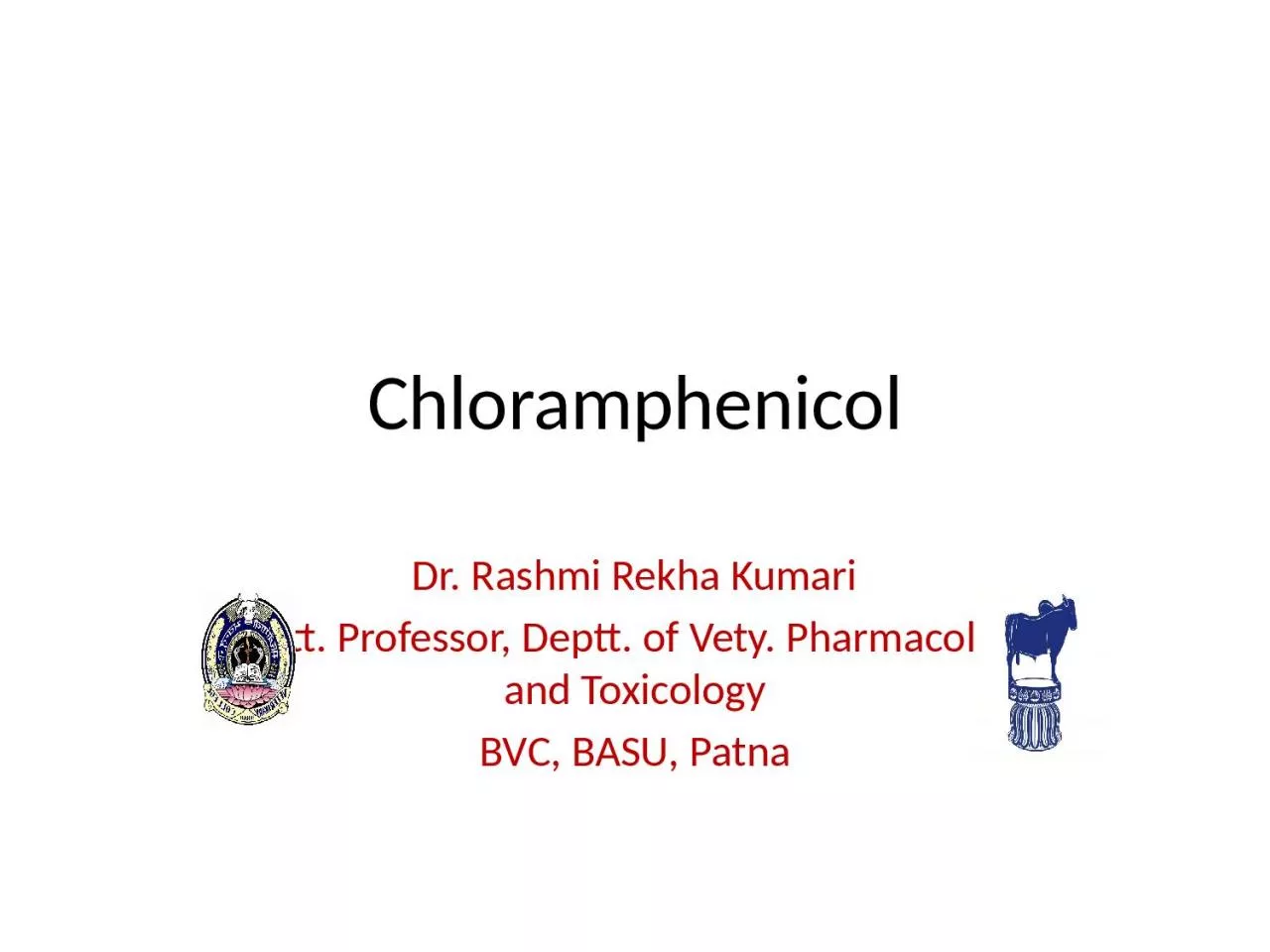

Rekha Kumari Asstt Professor Deptt of Vety Pharmacology and Toxicology BVC BASU Patna CHLORAMPHENICOL amp CONGENRS The isolation of chloramphenicol was reported ID: 1009740
Download Presentation The PPT/PDF document "Chloramphenicol Dr. Rashmi" is the property of its rightful owner. Permission is granted to download and print the materials on this web site for personal, non-commercial use only, and to display it on your personal computer provided you do not modify the materials and that you retain all copyright notices contained in the materials. By downloading content from our website, you accept the terms of this agreement.
1. ChloramphenicolDr. Rashmi Rekha KumariAsstt. Professor, Deptt. of Vety. Pharmacology and ToxicologyBVC, BASU, Patna
2. CHLORAMPHENICOL & CONGENRS The isolation of chloramphenicol was reported by Ehrlich, Burkholder and coworkers in the year 1947. It was naturally obtained from Streptomyces venezuelae and was the first antibiotic to be manufactured synthetically for clinically uses.
3. Chemistry It is yellowish white crystalline, intensely bitter solid. Its aqueous solution is stable, withstands boiling but need protection from light. It has a nitrobenzene substitution, which is responsible for its antimicrobial activity.
4. ChloramphenicolIt is highly effective broad spectrum antibiotic. But this drug causes severe blood dyscracias in human so carefully used in pet animals and not approved for use in food animals in many countries. Two chloramphenicol congeners viz. thiamphenicol and florfenicol(less toxic to bone marrow) have been developed.
5. Thiamphenicol: It is produced by replacing the nitro phenolic group chloramphenicol by a methylsulphonyl group .It is less effective but safer than chloramphenicol.Florfenicol: It is a fluorinated derivative of thiaphenicol, more effective than chloramphenicol, resist bacterial destruction and approved for use in cattle.
6. Antimicrobial spectrum It is a broad spectrum antibiotic effective against both Gram positive and Gram negative bacteria and several anaerobes (Bacteroides fragilis), as well as Rickettsia, chlamidia and Mycoplasma like tetracycline. It has special efficacy against Salmonella including S. typhi, but less action on Gram positive cocci.
7. Like tetracycline it is inactive against Mycobacteria, Pseudomonas, mainly Proteus spp, viruses and fungi.Florfenicol also has broad antimicrobial spectrum.Bacterial resistance is due to synthesis of chloramphenicol acetytransferase (plasmid mediated
8. Mechanism of actionChloramphenicol and its congeners bind to the 50 S subunit of the bacterial ribosome (at the same site as do erythromycin and clindamycin) and also interfere with the bacterial peptidyltransferase activity. These results in the inhibition of microbial protein synthesis due to interference with the transfer of elongated peptide chain to the newly attached aminoacyl-tRNA at the m-RNA –ribosome complex (i, e .transpeptidation).At high doses it also inhibits mammalian mitochondria protein synthesis particularly in bone marrow.
9. PharmacokineticsChloramphenicol palmitate, given orally, is rapidly and completely absorbed in monogastric animals and reaches peak plasma concentration within two hours. Florfenicol is also rapidly absorbed orally, although milk interferes with its absorption. In ruminants, the chloramphenicol is orally ineffective as it is readily inactivated (reduced to inactive aminochloramphenicol) by the ruminal micro flora and therefore given only parenterally.
10. Chloramphenicol sodium succinate administered by IM or IV route is hydrolysed into active free chloramphenicol. In plasma, 40-50 % reversibly binds to the plasma protein and the free fraction is widely distributed throughout the tissue and bodyFluids including CSF (florfenicol less), milk aqueous humor and placental fluid
11. Its unique property is the ability to attain high concentration in CSF (40-60% of plasma concentration), even in absence of meningeal inflammation. Chloramphenicol is mainly inactivated in liver by conjugation with glucuronic acid and also reduced to inactive amines and the metabolites are excreted in urine by active tubular secretion. Only 10% is excreted as free drug in urine by glomerular filtration.
12. Therapeutic usesThe use of chloramphenicol should be reserved for serious infectious in which the benefit of the drug is greater than the risk of toxicity.It is used for both local and systemic infection in animals. Drug of choice in salmonella and Bacteroides septicaemia
13. They are also used in bacterial meningoencephalitis , brain abscess ,ophthalmitis , mastitis (Intramammarily and parenterally), intraocular infections ,equine dermatophilus infection ,urinary tract infection (haematogenus delivery), superficial skin and in otitis externa (as1% topical prepration ). In human it is effective in typhoid and parathyroid fever but ciprofloxacin or amoxicillin and cotrimoxazole (In adult) or cefixime /ceftriazone (In children) are similarly effective and less toxic drugs.
14. ToxicityChloramphenicol in man (but not florfenicol) produces two types syndrome related to bone marrow depression.Non regenerative anaemia: Such blood dyscrasias may also be seen in susceptible neonatal animals treated with adult doses of chloramphenicol .This is the direct toxic effect of drug related to the interference with mRNA and protein Synthesis in rapidly multiplying bone marrow cells.Reversible aplastic anaemia: It is sometimes seen in dogs and cat, much more serious and related to idiosyncratic reaction. Thiamphencol and florfrenicol, without the nitro group, do not produce aplastic anaemia.
15. Gray baby syndrome: Chloramphenicol should be used with great care in newborns because inadequate inactivation and excretion of drug result in such toxic syndrome –vomiting, flaccidity, hypothermia and ashen grey cyanosis followed by CV collapse and death.Oral administration of chloramphenicol in Monogastric animal causes GI disturbances.
16. Drug interactionChloramphenicol (a potent microsomal enzyme inhibitor ) inhibits the metabolism of many other drug like phenytoin ,barbiturates, primidone ,local anaesthetics and thereby either prolong their action or precipitate toxicity.On the other hand ,phenobarbitone and phenytoin enhance chloramphenicol metabolism ,reduce therapeutic concentration and cause failure of chemotherapy .
17. It should not be combined with bactericidal drugs and drugs that bind to 50S ribosome subunit (macrolides and lincosamides).Dosage: Chloramphenicol: Oral Administration, calves and foals: 0.5gm, 2-3 times daily, dogs: 50-150 mg/kg, in three divided doses.Parenteral : Chloramphenicol sodium succinate 10% for IV and 40% IM injection ,large animal 2-4mg/kg,sheep goat, and calves : 4-10 mg/kg
18. Thank you